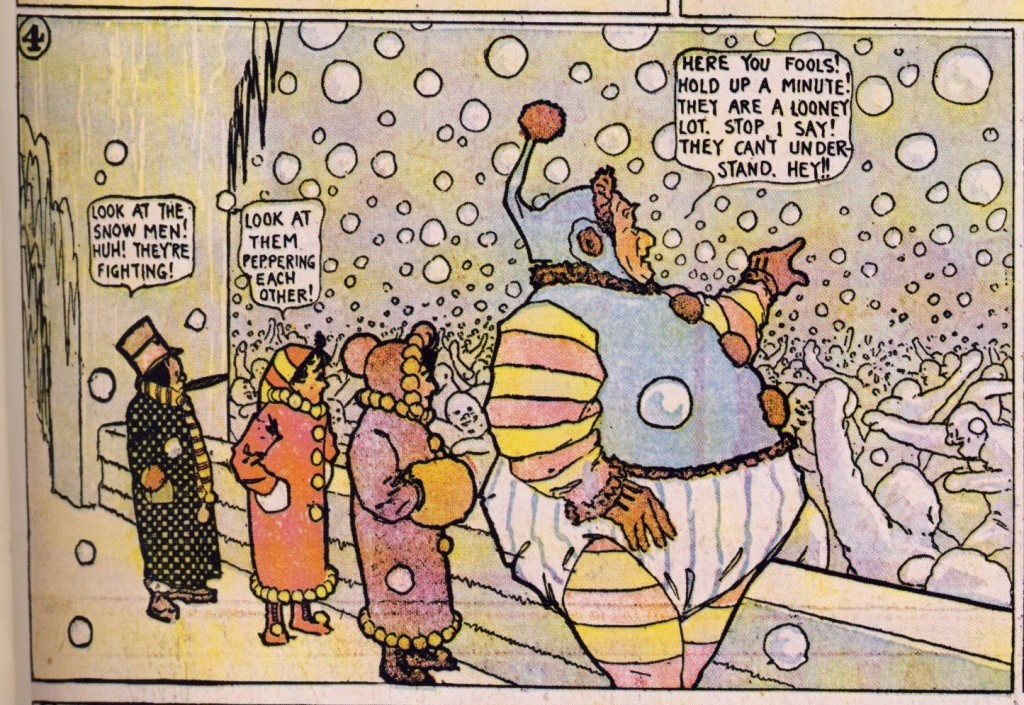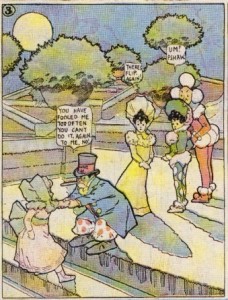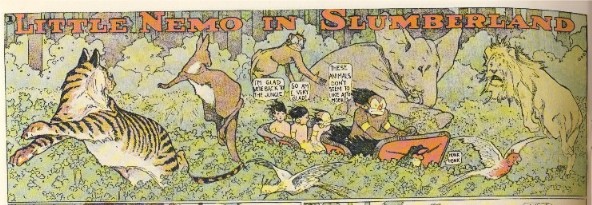Winsor McCay spoke the saddest and greatest last words of any cartoonist. (Number two is Osamu Tezuka: “I’m begging you, let me work!”) McCay lived to draw; his greatest fear, he often said, was of losing that ability. On a July evening in 1934, the 65-year-old cartoonist called downstairs to his wife, “It’s gone, Mother! Gone, gone, gone!” He had just suffered a stroke that paralyzed his right side. Shortly afterwards, he suffered a second stroke, from which he never recovered.
 His first thought when the stroke paralyzed him, the last thought he was able to articulate, was that he had lost his drawing hand.
His first thought when the stroke paralyzed him, the last thought he was able to articulate, was that he had lost his drawing hand.
Many cartoonists, even many great cartoonists, find drawing a chore. But McCay loved to draw. He lived to draw. He built a side career as an animator so he could draw even more. Each Little Nemo strip overflows with more careful, lovely illustration than most of us could produce in a lifetime. McCay crowded his strips with duplicates, clones, and herds of identical figures; he couldn’t think of any pastime more fun than drawing sixty kangaroos or a hundred children in clown suits. Figures stretch and warp and bend; the panels themselves strain to accommodate the artist’s imagination, tipping over and reforming into weird new shapes.
 This strip, of all strips, could never fill less than a full Sunday page. It’s wild and robust but strangely delicate, as if a strong breeze, or Mama calling from the kitchen, could dissipate McCay’s fine-lined, Art Nouveau fairyland.
This strip, of all strips, could never fill less than a full Sunday page. It’s wild and robust but strangely delicate, as if a strong breeze, or Mama calling from the kitchen, could dissipate McCay’s fine-lined, Art Nouveau fairyland.
This is what McCay loved so much, this Fabergé egg of a comic strip. He took pen in hand and sent readers tumbling into a shifting universe of princesses, dragons, elephants, hot-air balloons, ornate palaces, darkest wildernesses, walking beds, dreams that enter the waking world, and waking worlds that turn into dreams. At the end of each page Little Nemo wakes up and cries MAMA! And it’s gone.
Shaenon Garrity is an editor at Viz Media and the creator of the webcomic Narbonic. She writes about comics for comiXology, Otaku USA, and other publications.
NOTES
Little Nemo in Slumberland by Winsor McCay received 25.5 votes.
The poll participants who included it in their top tens are: Eric Berlatsky, Noah Berlatsky, Jeffrey Chapman, Hillary Chute, Seymour Chwast, Brian Codagnone, Corey Creekmur, Kathleen Dunley, Joshua Dysart, Jackie Estrada, Shaenon Garrity, Geoff Grogan, Danny Hellman, Kenneth Huey, Jones, one of the Jones Boys, Abhay Khosla, Sean Kleefeld, Chris Mautner, Joshua Paddison, Marco Pelliteri, Hans Rickheit, Matt Seneca, Matteo Stefanelli, Joshua Ray Stephens, Matt Thorn, and Mack White.
Hillary Chute specifically voted for the newspaper comic strips of Winsor McCay, which was counted as a 0.5 vote towards Little Nemo in Slumberland’s total.
Winsor McCay’s Little Nemo in Slumberland was a newspaper strip that was first published on October 15, 1905. The original run continued until April 23, 1911. There were two revivals. The first of these ran from April 30 to July 26, 1914. The final run of the strip was published between 1924 and 1927.
The strip is in the public domain. As such, there have been many competing book collections put out by publishers. The best, least expensive introduction (as well as the collection that does the most justice to the original published page sizes) is Dover Publications’ Little Nemo in the Palace of Ice, which retails for $14.95. Click here to view it on Google Books.
–Robert Stanley Martin

While the Dover edition may indeed be the “least expensive” it’s hard to see it as the “best” or “the collection that does the most justice to the original published page sizes.” Only the massive Sunday Press volumes really do the latter, though they are indeed expensive (but worth it for what they are). And the Dover provides only a thin selection — almost any of the other options (from Fantagraphics, Taschen, Tabori and Chang, or Checker) are worth seeking out for a better sense of the full range of this masterpiece.
I second Corey. The full-size one is very pricey (way out of my price-range), but there are more complete versions which are not unreasonably priced than the Dover.
Beautifully written, Shaenon. I never heard that story about Winsor’s final words.
Even though none of mine have made the top 10 yet, I have no objections. Each one deserves to be here. There’s just too much amazing material.
Not to distract from the argument over which collection is the best, but I just wanted to point out that this is a really lovely piece of writing. Nicely done Shaenon.
I also really enjoyed this (love the way you end the piece!) and it makes me realize what a disservice I have done by taking the time to read more Little Nemo. So I’ll be correcting that soon.
Noah Berlatsky wrote: “Not to distract from the argument over which collection is the best, but I just wanted to point out that this is a really lovely piece of writing. Nicely done Shaenon.”
Agreed! I didn’t realize that about Winsor and the stroke, and it’s amazing to think about how passionate he was. It’s eerie (as you suggest in the ending of your piece) that his comment echoes Nemo waking up at the end of each strip.
In 100 years no one has matched the sheer beauty and elegance of McCay’s artistry. Those lines. Those colors. And I’m not sure anyone will match him. For one, few have that skill and imagination. Also, Little Nemo is so much a product of the size of his page. Certainly the modern Sunday page, where a much-smaller page is chopped up into 6-8 strips, doesn’t give the artist the necessary space & freedom.
Lately I’ve been rereading the sequence where Nemo and crew are traveling across the country in a zeppelin of sorts. McCay drew these stunning drawings of the major cities of the time: Detroit, Chicago, Rochester NY. Having moved to Detroit two years ago, I find it fascinating to see how the city looked at the beginning of the 20th century (especially given the turmoil Detroit has seen since).
Thanks for the article!
Just so all the arguments aren’t in the Watchmen thread…
While I get the historical importance of Nemo/McCay for the form/medium. Little Nemo is aesthetically so old looking now. You look at it and it is so much of its time and… It’s impressive, but I don’t find it particularly beautiful. I admire McCay’s skill and inventiveness, but I find it really hard to actually read/look-at Little Nemo.
In contrast, something like Krazy Kat (which I did vote for), feels much more alive and lively and… readable.
See, I find Krazy Kat almost completely uninteresting, while McCay is ravishing.
Just goes to show….
I think reading Nemo is a mistake (or at least reading it closely). Better to just look…Some of the captions/bubbles are just mind-numblingly painful to actually read, no matter what size they are.
I see the attractions of Krazy, but find it much harder to ingest in large gulps.
Derik, I agree with you in one sense. I find McCay’s writing to be stilted and old-fashioned (in fact, I usually find his Dream of the Rarebit Fiend a little bit fresher, in terms of writing. Perhaps because it isn’t focalized through a child, so the diction & themes are less stylized and juvenile?), but I don’t feel that way about the art. When I turn to McCay, I often gloss over the writing and just lose myself in the art.
Actually, in some ways it’s useful to turn to the black-and-white work of the Rarebit Fiend for that as well. Something about seeing the artwork without the color emphasizes the elegance of the lines. People talk about the elegant inkwork of Kelly’s Pogo (and how it influenced the elegant inkwork of Jeff Smith’s Bone), but I don’t think there’s more nuanced line in any comics.
Of course this isn’t always what one wants. I tend to prefer the painterly inkwork of Hugo Pratt, Baudoin, Craig Thompson, or Milton Caniff, but I love McCay in his own way.
I would rather READ Herriman too. He is better literature, IMO.
Pingback: Little Nemo in Slumberland | Mimi Berlin